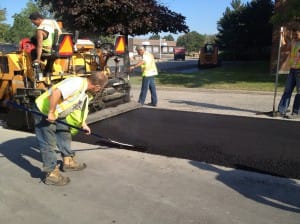The Only Guide to A1 Professional Asphalt & Sealing Llc
The Only Guide to A1 Professional Asphalt & Sealing Llc
Blog Article
A1 Professional Asphalt & Sealing Llc Fundamentals Explained
Table of ContentsExcitement About A1 Professional Asphalt & Sealing LlcA1 Professional Asphalt & Sealing Llc Fundamentals ExplainedMore About A1 Professional Asphalt & Sealing LlcNot known Facts About A1 Professional Asphalt & Sealing LlcIndicators on A1 Professional Asphalt & Sealing Llc You Should Know

The oil in an auto engine is not simply oil. It consists of a range of ingredients to enhance the car's efficiency. These include polymers, viscosity modifiers, heat stabilizers, extra lubricating substances, and put on ingredients. The REOB consists of all the ingredients that remained in the waste oil in addition to the wear metals from the engine (mainly iron and copper).
By making numerous blends utilizing various REOB samples and different asphalt binders, the variations mostly can be balanced out. Several States offered examples of well-known REOB make-up to TFHRC scientists, that examined the examples to contrast the percentage of included (known) REOB to the found (evaluated) quantity. The analyses showed a similar portion of added and found REOB.
The Basic Principles Of A1 Professional Asphalt & Sealing Llc
None of those States realized that the asphalt they were buying consisted of REOB. One State urged its samples had no REOB - https://gravatar.com/a1asphaltsealng.
Of the 1,532 samples checked, 12 percent included REOB, and some had significantly high levels of it at 1020 percent. The highest level was 34 percent in an example from Texas, which TxDOT had actually utilized in a patching compound. This screening also disclosed the existence of phosphoric acid in 11 percent of the examples, and 2 percent included ground tire rubber.
2 years back at TRB's annual conference, the Federal researchers held an REOB workshop and provided the searchings for of their laboratory evaluations to a standing room-only group. Some firms do not specifically ban REOB, they do enforce physical tests that avert its useeffectively a ban. Others do not outlaw it by specification, yet have contracts with asphalt suppliers to stay clear of making use of REOB
The 6-Minute Rule for A1 Professional Asphalt & Sealing Llc
A handful do allow REOB, some within certain restrictions. For example, Ohio and Texas limit levels to less than 5 percent of the asphalt. To create a trustworthy examination approach that all States can make use of, the TFHRC scientists set up a round-robin examination plan. The participants are 11 State highway agencies (Illinois, Massachusetts, Minnesota, Mississippi, Montana, North Carolina, Oklahoma, South Carolina, Texas, Vermont, and Wyoming), 2 independent screening labs, the Ministry of Transportation in Ontario, Queen's College in Ontario, and an Ontario paving contractor.
In total amount, the researchers prepared and shipped 720 blends. The individuals are examining the examples independently utilizing the guidelines supplied by the TFHRC scientists. The round-robin screening is virtually completed, and TFHRC is in the procedure of collecting the results. The result will certainly be a proposed AASHTO test technique that any type of State can embrace and utilize (asphalt repairs).
The sidewalk with REOB, which is situated 0.6 mile (1 kilometer) from the sidewalk without REOB, has the same subgrade, traffic density, and environment. Nevertheless, the sector of Highway655 with 5 to 10 percent REOB showed significant breaking. In this example, the existence of REOB was the identified cause of fracturing at a low useful source temperature levels.
A section of test sidewalk in Minnesota (MN1-4) discovered to consist of REOB additionally broke prematurely. The sidewalk executed well for the very first 3 to 4 years, but after that began to break.
Our A1 Professional Asphalt & Sealing Llc PDFs
The examinations were not comprehensive, but they revealed that at levels of 6 percent or even more, the tensile strength of the asphalt went down substantially. At a degree of 3.5 percent REOB, the variant in the physical examination techniques was more than the impact of REOB. It was difficult for scientists to examine whether REOB was present. https://fliphtml5.com/homepage/unsho/a1asphaltsealng/.

One binder criterion thought about is the difference between the low temperature important spec temperature level for tightness (S) in the bending beam of light rheometer and the flexing beam rheometer creep slope (m-value) noted as Tcritical. Two independent research teams, one from AASHTO and the various other from the Asphalt Institute, wrapped up that more study is required on the use of REOB in asphalt.
Formerly, all asphalt testing determined design properties such as tightness. These tests do disappoint what products had been included in the asphalt. One example received throughout the TFHRC research had a very unusual evaluation. The example had the complying with test results: Superpave PG 64-28 with a high temperature level quality of 67.3 Tcritical on the flexing beam rheometer was 6.7 degrees Celsius.

Examine This Report about A1 Professional Asphalt & Sealing Llc
These outcomes demonstrate there are weaknesses in the standard engineering testing procedures that might be exploited. The manufacturer might have an economic advantage and the item passes all the standardized tests, however the item might not be useful to making certain long-lasting performance. To address this problem and the expansion of new asphalt ingredients and extenders, TFHRC is starting a study program to use portable spectroscopic tools, x-ray fluorescence spectroscopy, and Fourier change infrared spectroscopy to enable evaluations to be carried out in the area instead of having to take examples back to the laboratory.
Report this page